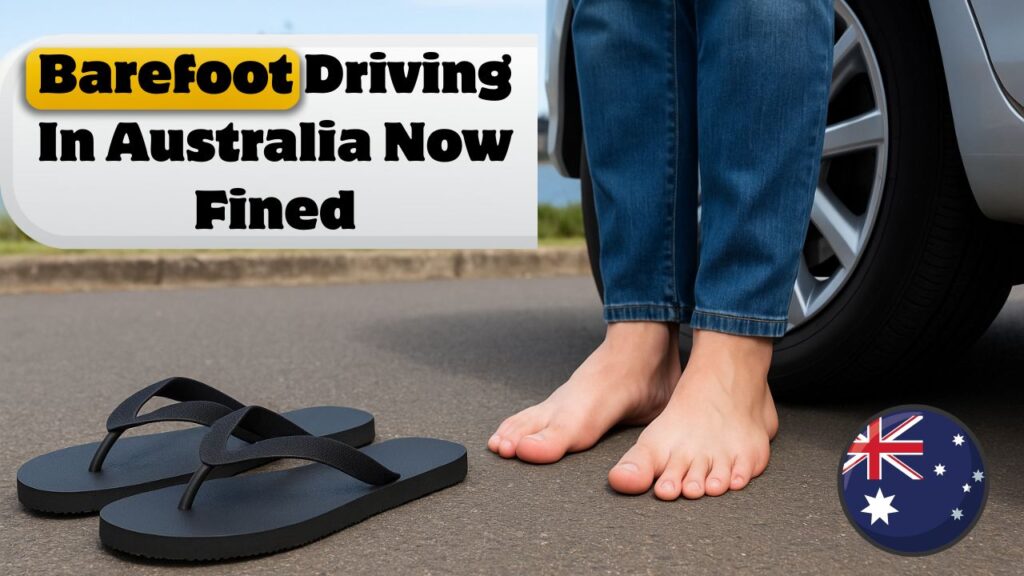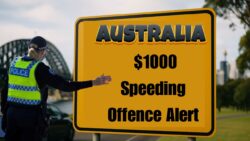Australia Flip-Flops and Fines 2025 – Many Australian drivers are still confused about whether it’s illegal to drive barefoot or while wearing flip-flops in 2025. With stricter traffic rules and heavy fines introduced across several states, this question has become more important than ever. While most Australians prefer comfort when driving during hot summers, not all footwear—or lack of it—is considered safe. This article explains the actual laws regarding barefoot driving in Australia, what’s legal, what could get you fined, and how safety guidelines from transport authorities affect everyday drivers.

Driving Barefoot in Australia – What the Law Says
For Australian citizens, there is no direct law that makes driving barefoot illegal. However, the Australian Road Rules state that drivers must have proper control of their vehicles at all times. If being barefoot or wearing loose footwear like flip-flops causes you to lose control, you could face serious fines or charges for careless driving. Each state and territory has its own enforcement policies, but all emphasize the importance of safety and control. Police officers can issue penalties if your footwear—or lack thereof—creates a safety risk while driving.
Flip-Flops and Fines – What Australian Drivers Need to Know
Australians often wear flip-flops or thongs while driving, especially in coastal regions. However, these can easily slip off and get stuck under pedals, leading to dangerous situations. Transport authorities across Australia recommend wearing secure shoes with good grip while driving. If your choice of footwear contributes to an accident or prevents safe control of the vehicle, insurance claims might also be denied. Though it’s not technically “illegal” to wear flip-flops, doing so could still attract fines if it results in unsafe driving behaviour observed by authorities.
| State/Territory | Is Barefoot Driving Illegal? | Recommended Footwear Policy | Possible Fine (if unsafe) |
|---|---|---|---|
| New South Wales | No | Closed shoes recommended | Up to $481 |
| Victoria | No | Secure footwear required for safety | Up to $495 |
| Queensland | No | Avoid thongs or sandals | Up to $575 |
| Western Australia | No | Flat, secure footwear advised | Up to $600 |
| South Australia | No | Must maintain full vehicle control | Up to $554 |
Safe Driving Practices Across Australian States in 2025
Across Australia, road safety campaigns in 2025 emphasize responsible footwear while driving. Authorities have reported cases where sandals or flip-flops slipped under pedals, causing avoidable crashes. Driving barefoot might not seem dangerous, but without firm pressure and grip, it can reduce reaction time and control. To avoid fines and maintain safety, drivers are urged to wear suitable shoes designed for driving—flat, flexible, and non-slip. Following these guidelines ensures not only compliance with the law but also your safety and that of others on the road.
Australian Road Safety Advice for Everyday Drivers
Australian government transport departments regularly issue advisories about safe driving behaviour, including appropriate footwear. Motorists are encouraged to keep a spare pair of driving shoes in their vehicles, especially during summer months when flip-flops or bare feet are common. This simple precaution helps prevent accidents and eliminates any confusion about legality. By prioritizing safety over convenience, Australians can enjoy worry-free driving and avoid potential fines under careless or improper control regulations.
Frequently Asked Questions (FAQs)
1. Is it illegal to drive barefoot in Australia?
No, it’s not illegal to drive barefoot, but you must always remain in full control of your vehicle.
2. Can I wear flip-flops while driving in Australia?
Yes, but it’s not recommended as flip-flops can slip and cause loss of control.
3. Can police fine me for driving without shoes?
Police can fine you if driving barefoot leads to unsafe control or an accident.
4. What kind of shoes are safest for driving in Australia?
Flat, closed, and flexible shoes with good grip are considered safest for Australian roads.




